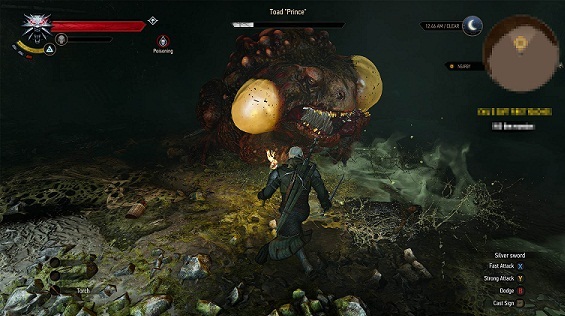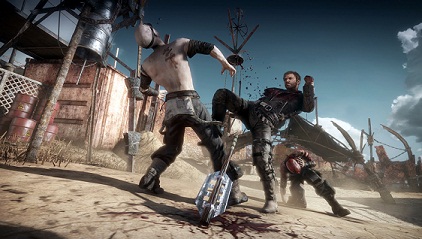

For those of you Kinect owners who have been hoping for more than sports mini-games and dance simulators to utilize the ‘next generation’ of motion controls, there’s a good chance that you’ve heard of Ubisoft’s superhero fighter PowerUp Heroes.
Even if you haven’t been keeping tabs on the game, the premise definitely offers a compelling blend of Kinect functionality, fighting game action, and Xbox Live brand fun. But even if PowerUp Heroes brings superpowers to every player’s Xbox Live avatar, does this game manage to be more than an hour-long flash in the pan experience?
Yes and No. It’s becoming difficult these days to judge a Kinect game based solely on the work of the developers – and take the limitations and technological hurdles of the device out of the equation. While recent games have made huge strides for Microsoft’s motion control, like The Gunstringer and more recently Kinect Sports: Season Two, the transition of Kinect into the fighting genre is as problematic as might be expected.
It’s hard to fault Ubisoft, since in all honesty, the announcement of the device’s first superhero-simulation was intended to provide players with an experience they had been calling for. The developers at Longtail Studios have made several smart design choices in bringing a highly-polished and instantly satisfying experience, and right off the bat PowerUp Heroes is likely to surprise.
From its sleek, comic-book inspired visuals and cut scenes, to its quick and punchy animations, PowerUp Heroes is undoubtedly the title that every gamer wished was available when they were a grade schooler. Tasked with defending the Earth from the evil invader Malignance, the player (in the form of their Xbox Live avatar) is granted the ability to wield a number of super-powered suits of armor, each with their own unique attacks.
Starting with an electricity-charged suit, the player begins taking on minion after minion of Malignance, acquiring the suits of the vanquished foes along the way. That’s as far as the game goes in terms of story, which was a wise choice, considering how some games (see Rise of Nightmares review) wrongfully attempted to tell long and dense narratives in what is undeniably a more casual medium. This outline of a story is all the player is forced to accept, which means that the gameplay and combat itself are allowed to take center stage.
The game wastes no time in throwing the player into the action, facing off against opponents with a variety of ranged and melee attacks. Equipped with two different suits that can be swapped on the fly, the player can choose between three different special attacks triggered by large gestures, or raise a leg to move in close, delivering a punch and kick-based combination. The special attacks themselves are satisfying for the most part, and bonuses are awarded for chaining together different moves, with extra damage inflicted for swapping between suits in the process. In that regard, the combat itself is much deeper and open to strategy than might be expected.
With a variety of suits, there is sure to be one form of attack that everyone has dreamed of wielding in defense (hopefully) of innocent civilians. Whether it’s slamming a fist into the ground to deliver a magma-fueled wave of earth, encapsulating your opponent in a massive wooden totem pole, or using a good old-fashioned chaingun, the attacks themselves do what they must: make you feel cool playing it – and in the moment-to-moment gameplay, PowerUp Heroes does that beautifully.
But beyond the basic concept, the actual gameplay is not so successful. Taking on opponent after opponent can be a boost to your ego, and racking up victories makes the lag inherent in dodging attacks or stringing together large gestures easier to bear. However, by the time you make it to the game’s bigger and badder enemies, cracks start to appear. While challenging a player to react faster and rethink their strategies is all well and good – the developers need to remember that this is a Kinect game and that the device, itself, limits the player’s reaction times.
If there is one rule that should be adopted by every single game designer with a Kinect project in the works, it should be this: hardcore challenging a player is not a realistic goal. If your game is built on making a player (likely a younger one) act silly in living out a superhero fantasy, what reason could there possibly be for making them feel weak? Physical exertion aside, PowerUp Heroes‘ shift in difficulty is so dramatic and sudden, that in my personal experience, the first defeat I was faced – was also the end of my progression. Changing suits, strategies, even taking a defensive approach all resulted in a half-emptied health bar – all before launching a single attack.
There’s nothing that says a Kinect game can’t be hard, but taking on more powerful enemies who are completely unrestrained by human input means a fun experience comes to a screeching halt. After an hour or two of satisfying, yet still challenging gameplay, every instance of lag means damage taken, and every unread gesture means likely death. With most of the game’s fun being derived from mixing and matching samurai attacks with necromancy, getting killed before being able to use these powers is a complete waste.
The sudden increase in difficulty is definitely the most recognizable feature of today’s genre of fighting games, but it really has no business in a Kinect title, presumably meant to appeal to a wide range of players. The shift from fun to frustrating is only compounded by the unlockable suits of both Assassin’s Creed‘s Ezio, and the Prince of Persia himself. While hours of perseverance may lead to successfully unlocking these special suits, the fact that many fans of Ubisoft will never be able to enjoy them is a real tragedy.
The game also features play across Xbox Live (but don’t count on many available matches) and local versus mode. The ability for two players to compete next to one another is an added bonus, and one that will likely offer both a good amount of fun and physical activity for younger gamers. That said, it is possible for the game’s lag to result in some major frustration as well as cheap victories, and subsequently real-life combat, so players should be warned.
PowerUp Heroes offers an experience that Kinect owners have no doubt been looking forward to, and does deliver on the promise of some inventive and polished motion gaming. Unfortunately, trying to find anything more than a bite-sized experience from the game is likely to result in frustration at higher difficulties, compounded by the altogether small single-player experience.
PowerUp Heroes is a sure-fire purchase for those with younger children or anyone who wants a (mostly) light-hearted superhero simulation fighter. The game could have offered a lot more, whether it be several more suits, a suit-creation system, or even a free-roaming combat mode to mix and match attacks on more than one enemy at once. As it stands, the game accomplishes the task of bringing a fighter to the Kinect, and puts superpowers into the gestures of every man and woman, but clings too closely to old habits to truly be out of this world.
PowerUp Heroes is available now, exclusively for the Xbox 360 with Kinect.
Follow me on Twitter @andrew_dyce.



